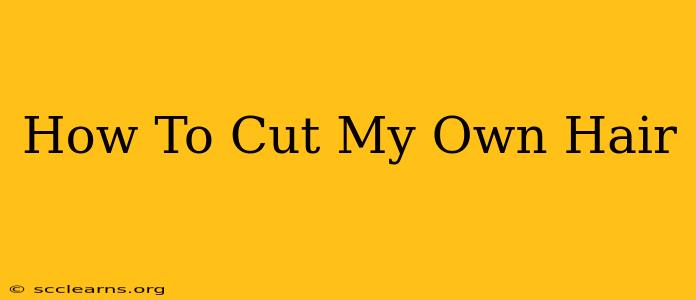Cutting your own hair might seem daunting, but with the right tools and techniques, you can achieve a surprisingly good result. This comprehensive guide will walk you through the process, helping you confidently trim your tresses at home. Whether you're aiming for a simple trim or a more significant style change, we've got you covered.
Preparing for Your DIY Haircut
Before you even pick up a pair of scissors, preparation is key. This phase ensures a smooth and successful haircut.
Gather Your Supplies:
- Sharp Hair Cutting Scissors: This is non-negotiable. Dull scissors will cause split ends and an uneven cut. Invest in a good pair specifically designed for hair.
- Hair Clips: These are essential for sectioning your hair, allowing for precise cuts.
- Wide-Tooth Comb: This helps detangle your hair and create neat sections.
- Spray Bottle: Keep your hair slightly damp to prevent snagging and ensure a clean cut.
- Mirror: You'll need at least one, preferably two (a handheld mirror in addition to a regular mirror) to see the back of your head.
- Optional: Hair Cutting Shears (Thinning Shears): These are useful for blending layers and removing bulk, but are not necessary for all cuts.
Assess Your Hair:
- Hair Type: Is your hair thick, thin, straight, wavy, or curly? Understanding your hair type will inform your cutting technique.
- Current Style: Take a good look at your current hairstyle. Identify any areas that need trimming or shaping.
- Desired Style: Have a clear picture in mind of the haircut you want to achieve. Look at pictures for inspiration. Starting with a small change is always recommended for beginners.
Basic Haircutting Techniques
Now that you're prepared, let's dive into some fundamental haircutting techniques.
Sectioning Your Hair:
Proper sectioning is crucial for an even cut. Use your clips to divide your hair into manageable sections, usually working from the bottom up.
Trimming Your Ends:
- Start Small: Begin by trimming small amounts of hair at a time. It's much easier to cut more off than to put it back!
- Point Cutting: This technique involves holding your scissors vertically and snipping into the ends, creating a softer, less blunt finish. It's ideal for removing split ends.
- Blunt Cutting: Hold your scissors horizontally for a clean, straight cut. This works best for straight hair.
Layering Your Hair:
Layering can add volume and texture. This technique is more advanced and might require practice. Consider watching video tutorials specific to layering for your hair type and desired style.
Cutting Specific Hair Styles
The exact process varies depending on the haircut you are attempting.
Trimming Bangs:
Bangs require precision. Work with small sections and cut less than you think you need.
Cutting Long Layers:
Long layers require careful sectioning and a gradual approach.
Short Haircuts:
Short haircuts are best left to professionals unless you're already very experienced in cutting hair.
Tips for Success
- Work in well-lit areas. Good lighting is essential for accurate cutting.
- Take your time. Rushing will likely result in mistakes.
- Cut less than you think you need. You can always trim more, but you can't add back hair you've already cut.
- Watch video tutorials. YouTube is a treasure trove of how-to videos demonstrating various haircutting techniques.
- Don't be afraid to start small. A small trim is less risky than a major style change.
When to Call a Professional
While cutting your own hair can be a rewarding experience, some situations call for professional help. If you are attempting a complex style, have thick or heavily layered hair, or are unsure about any aspect of the process, it is always best to consult a hairstylist.
This guide provides a foundation for cutting your own hair. Remember, practice makes perfect. Start with small changes, and you'll soon be confidently trimming your hair at home.

